|
 In the same work Verco also named a somewhat similar
shell Olivella solidula (Ibid. p. 39; figs. 7, 8; our
Fig. 6). It was taken from
Encounter Bay, South Australia, quite near the type locality of O.
adiorygma and about 800 miles east of Hopetoun. He characterized it
as "solid, shining white, smooth, obliquely elongate-oval. Apex blunt,
four whorls, sloping convex, suture well channelled. Aperture oval,
contracting gradually to a linear gutter posteriorly, widely-open in
front, and notched; outer lip simple, smooth; inner lip is a narrow, thick
glaze over the base to the suture, slightly spreading over the columella
.... 6 mm. (by) ... 2.3 mm." As seen in Fig.
6, the shell has relatively narrowly-channeled sutures and
no evident fasciolar or pillar sculpture. The absence of the latter
features contrasts with Olivella [now Belloliva]
exquisita Angas, 1871, which Verco wrote "it closely resembles [but
differs] in being smaller, narrower and pure-white." A solitary specimen
which matched the type illustration of Olivella solidula was found
in my lot of Hopetoun Ramoliva adiorygma. Most regrettably, this
shell was accidentally crushed in preparation for scanning. Our
Fig. 7 is a 8.2 mm B. exquisita in my
collection taken near
shore, Cogee Bay, NSW, Australia. An image of another specimen whitened
with magnesium oxide (Kaicher, 1987; card 4966;
Fig. 8) more clearly demonstrates the pillar and fasciolar
features, which are absent from Olivella solidula. In the same work Verco also named a somewhat similar
shell Olivella solidula (Ibid. p. 39; figs. 7, 8; our
Fig. 6). It was taken from
Encounter Bay, South Australia, quite near the type locality of O.
adiorygma and about 800 miles east of Hopetoun. He characterized it
as "solid, shining white, smooth, obliquely elongate-oval. Apex blunt,
four whorls, sloping convex, suture well channelled. Aperture oval,
contracting gradually to a linear gutter posteriorly, widely-open in
front, and notched; outer lip simple, smooth; inner lip is a narrow, thick
glaze over the base to the suture, slightly spreading over the columella
.... 6 mm. (by) ... 2.3 mm." As seen in Fig.
6, the shell has relatively narrowly-channeled sutures and
no evident fasciolar or pillar sculpture. The absence of the latter
features contrasts with Olivella [now Belloliva]
exquisita Angas, 1871, which Verco wrote "it closely resembles [but
differs] in being smaller, narrower and pure-white." A solitary specimen
which matched the type illustration of Olivella solidula was found
in my lot of Hopetoun Ramoliva adiorygma. Most regrettably, this
shell was accidentally crushed in preparation for scanning. Our
Fig. 7 is a 8.2 mm B. exquisita in my
collection taken near
shore, Cogee Bay, NSW, Australia. An image of another specimen whitened
with magnesium oxide (Kaicher, 1987; card 4966;
Fig. 8) more clearly demonstrates the pillar and fasciolar
features, which are absent from Olivella solidula.
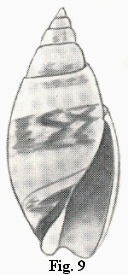 Olivella solidula was not treated in Wilson
(1994), but he synonymized Olivellopsis Thiele
with Belloliva
Peile, 1922 [type Olivella brazieri Angas, 1877; Cotton, 1955, fig.
9; our Fig. 9], which, like
Belloliva exquisita and B. triticea (Duclos, 1835), has a twisted pillar and
conspicuous fasciolar sculpture. In fact, O. solidula, particularly
a stout form illustrated by Cotton (1955; fig. 11; our
Fig. 10), bears a closer
resemblance to Olivellopsis simplex (Pease, 1868),
Fig. 4, than
either does to Belloliva brazieri. Olivella solidula and
Olivellopsis simplex may well be congeneric. The two smaller shells in
Fig. 1 resemble both these
species. Upon close examination of its dorsal aspect, each of the smaller
Fig. 1 shells has a very faint fasciolar groove/ridge which meets the
outer lip just behind its anterior extremity (as was the case with the
destroyed Hopetoun shell). Although Paul Callomon (personal comm., Sept.
17, 2004) could see no such feature in the Pease lectotype,
in this cosmopolitan and apparently natural group
it is a very
subtle character which may be effaced in older or abraded shells.
If this feature proves consistent from one form to the next, and in
consideration of the channeled sutures of these shells, this group of four
putative taxa are likely very close to or in the Olivella (sensu
lato). Olivella solidula was not treated in Wilson
(1994), but he synonymized Olivellopsis Thiele
with Belloliva
Peile, 1922 [type Olivella brazieri Angas, 1877; Cotton, 1955, fig.
9; our Fig. 9], which, like
Belloliva exquisita and B. triticea (Duclos, 1835), has a twisted pillar and
conspicuous fasciolar sculpture. In fact, O. solidula, particularly
a stout form illustrated by Cotton (1955; fig. 11; our
Fig. 10), bears a closer
resemblance to Olivellopsis simplex (Pease, 1868),
Fig. 4, than
either does to Belloliva brazieri. Olivella solidula and
Olivellopsis simplex may well be congeneric. The two smaller shells in
Fig. 1 resemble both these
species. Upon close examination of its dorsal aspect, each of the smaller
Fig. 1 shells has a very faint fasciolar groove/ridge which meets the
outer lip just behind its anterior extremity (as was the case with the
destroyed Hopetoun shell). Although Paul Callomon (personal comm., Sept.
17, 2004) could see no such feature in the Pease lectotype,
in this cosmopolitan and apparently natural group
it is a very
subtle character which may be effaced in older or abraded shells.
If this feature proves consistent from one form to the next, and in
consideration of the channeled sutures of these shells, this group of four
putative taxa are likely very close to or in the Olivella (sensu
lato).
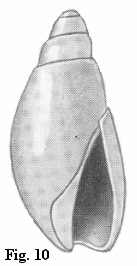 Based on the findings above, the diagnosis of these
three shells in Fig 1 is (left to right): Olivellopsis species
A [Olivellinae?; first Atlantic and New World record?],
Ramoliva adiorygma (Verco, 1909) [Columbellidae?], Olivellopsis
species B [Olivellinae?; first Indian Ocean
record?]. Needless to say, I appeal to readers to be on the lookout
for other material comparable to these three odd "Rice Olives" so that we
can better appreciate the systematic relationships of each. Based on the findings above, the diagnosis of these
three shells in Fig 1 is (left to right): Olivellopsis species
A [Olivellinae?; first Atlantic and New World record?],
Ramoliva adiorygma (Verco, 1909) [Columbellidae?], Olivellopsis
species B [Olivellinae?; first Indian Ocean
record?]. Needless to say, I appeal to readers to be on the lookout
for other material comparable to these three odd "Rice Olives" so that we
can better appreciate the systematic relationships of each.
Acknowledgements: I am indebted to Adam Baldinger (MCZ) for provision
of the Johnson reference, Paul Callomon (ANSP) for examining and
photographing the lectotype of Olivella simplex, Bill Frank
(Jacksonville, FL, USA) for assistance in the preparation of the figures
and layout, Jochen Gerber (Field Museum, Chicago, USA) for translation of
the Thiele passage from German, Dr. Patty Jansen (Lindfield, NSW,
Australia) for the provision of critical portions of the Verco monograph,
and Richard E. Petit (North Myrtle Beach, SC, USA) for access to Pease's
original paper.
Literature cited:
Cotton, B. C., 1955. Family Olividae. Royal Soc. South Austral. Mal.
Section, pamphlet no. 6. 3 pp. (not paginated) + 1 pl. May 30.
Cotton, B. C. and F. K. Godfrey, 1932. South Australian shells. South
Australian Naturalist 13: 35-86.
Iredale, T., 1924. Results from Roy Bell's molluscan collections.
Proc. Linnean Soc. New South Wales 49: 179-278, pls. 33, 34. Oct. 24.
Johnson, R. I., 1994. Types of shelled Indo-Pacific mollusks described by
William Harper Pease (1824-71). Bull. Mus. Comp. Zoology 154(1):
1-61.
** Kaicher, S. D., 1987. Olividae part II no. 49 [card nos. 4942
through 5046]. Card catalogue of world-wide shells. Published
privately, St. Petersburg, Florida. Aug.
Kay, E. A. and W. J Clench, 1975. A biobibliography of William Harper
Pease, malacologist of Polynesia. Nemouria. Occasional papers of the
Delaware Museum of Natural History 16: 1-50. Dec. 30.
Olsson, A. A., 1956. Studies on the genus Olivella. Proc. Acad. Nat.
Sci. 108: 155-225 + pls. 8-16.
Pease, W. H., 1868. Descriptions of sixty-five new species of marine
Gasteropodae, inhabiting Polynesia. American Journal of Conchology 3:
271-297, pls. 23, 24.
Rosenberg, G. and R. E. Petit, 2003. Kaicher’s card catalogue of
world-wide shells: a collation with discussion of species named therein.
The Nautilus 117(4): 99-120. Dec. 23.
Thiele, J. 1929-1931. Handbuch der Systematischen Weichtierkunde. Bd 1.
Jena: Gustav Fischer, vi + 778 pp.
Verco, J., 1909. Notes on South Australian marine mollusca with
descriptions of new species, part XII. Trans. Roy. Soc. S. Australia
33: 293-342.
Wenz, W., 1938-1944. Handbuch der
Paläzoologie, herausgegeben von O.H. Schindewolf. Band 6. Gastropoda:
Allgemeiner Teil und Prosobranchia 1-946 + xii; 947-1507-1639 +
1*-10.* |
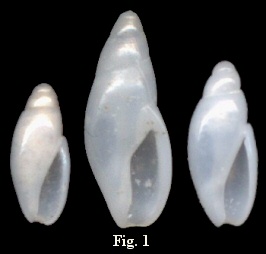 Among the many puzzling specimens in
my collection are three somewhat similar lots of marine snail shells
looking like tiny grains of white rice (Fig. 1).
From left to right, these examples measure 3.9, 6.2, and 4.7 mm and originate
(respectively) in a sediment sample taken at 60 ft. on Newport Reef,
CURACAO by a physician colleague, Dr. Mike Loper, on 2/20/04; on the beach
at Hopetoun, along the south coast of Western AUSTRALIA, found 1973,
originally labelled "Ramoliva adiorygma (Verco, 1909)," and
reaching me through Werner Massier on May 2, 2003; and in a cave in 30-35
m., off Old Shark Pt., Vilini Is., MALDIVES, collected on 11/13/94 and
obtained from Ross Mayhew circa 1998.
Among the many puzzling specimens in
my collection are three somewhat similar lots of marine snail shells
looking like tiny grains of white rice (Fig. 1).
From left to right, these examples measure 3.9, 6.2, and 4.7 mm and originate
(respectively) in a sediment sample taken at 60 ft. on Newport Reef,
CURACAO by a physician colleague, Dr. Mike Loper, on 2/20/04; on the beach
at Hopetoun, along the south coast of Western AUSTRALIA, found 1973,
originally labelled "Ramoliva adiorygma (Verco, 1909)," and
reaching me through Werner Massier on May 2, 2003; and in a cave in 30-35
m., off Old Shark Pt., Vilini Is., MALDIVES, collected on 11/13/94 and
obtained from Ross Mayhew circa 1998.
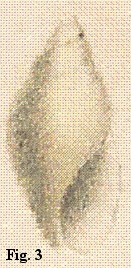
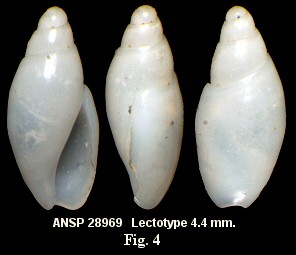
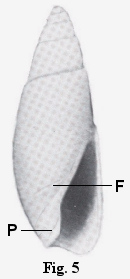 Let's consider the largest shell first. Sir Joseph
Verco named Olivella (?) adiorygma (1909; p. 338. pl.
25, figs. 3,4; our Fig. 2) from
17 fathoms, Backstairs Passage, South Australia; the type is 5.2 mm in
length. Cotton and Godfrey (1932; p. 54) designated it the type of
Ramoliva, new genus. Wenz (1943; p. 1272, Abb 3621) synonymized
Ramoliva with Olivellopsis Thiele, 1929 (p. 333; fig. 384), but
the type (by original designation) of the latter generic unit, Olivella
(Callanax) simplex Pease, 1868 was first described thus: "Long. 4 1/2,
diam. 2 mill. ... Paumotus ... Shell somewhat fusiform, truncate at base,
smooth, white; whorls four, marginated and slightly angulate at sutures;
spire somewhat produced; outer lip simple, smooth within; aperture wide;
columella slightly curved and callous. The generic characters of the
above are doubtful. It may prove the type of a new genus. If correct, it
is the first species of Olivella described from Polynesia" [p. 281;
pl. 23, fig. 24; our Fig. 3].
The Pease species, although poorly illustrated, has a different profile
and suture than the Verco species. Thiele (1929), in defining
Olivellopsis, wrote: "Schale sehr klein, farblos, Naht mehr angedrückt,
Spindelschwiele ohne untere Falte." Translated by Jochen Gerber on
August 24, 2004: "Shell very small, colorless, suture more appressed [than
Belloliva Peile, 1922; see below], columellar callus without lower
fold." Just what "more appressed" means is critical to the understanding
of this taxon; is the suture channelled or not? Since the identity of the
Pease species (and thus Olivellopsis Thiele, 1929) was not at all
clear, it was imperative to get an authentic specimen if this problem was
to be worked out. Thus I searched my library for leads on the location of
Pease's collection and promptly found a bio-bibliography of Pease (Kay and
Clench, 1975), which indicated that "a great many of Pease's species are
in the Pease collection of the Museum of Comparative Zoology [MCZ],
Harvard University; others are in the British Museum (Natural History) and
in the Academy of Natural Sciences of Philadelphia [ANSP]." I wrote Adam
Baldinger at the MCZ, who replied almost immediately that in a more
detailed report on the Pease collections (Johnson, 1994; p. 24) located
Pease's Olivella simplex at the ANSP and designated a lectotype and
paralectotype. Collections Manager Paul Callomon kindly provided me with a
photograph of the lectotype (ANSP 28969; Fig.
4). Clearly Olivella simplex Pease, 1868 is not
a close relative of Olivella adiorygma Verco, 1909. We shall
postpone discussion of O. simplex temporarily.
Let's consider the largest shell first. Sir Joseph
Verco named Olivella (?) adiorygma (1909; p. 338. pl.
25, figs. 3,4; our Fig. 2) from
17 fathoms, Backstairs Passage, South Australia; the type is 5.2 mm in
length. Cotton and Godfrey (1932; p. 54) designated it the type of
Ramoliva, new genus. Wenz (1943; p. 1272, Abb 3621) synonymized
Ramoliva with Olivellopsis Thiele, 1929 (p. 333; fig. 384), but
the type (by original designation) of the latter generic unit, Olivella
(Callanax) simplex Pease, 1868 was first described thus: "Long. 4 1/2,
diam. 2 mill. ... Paumotus ... Shell somewhat fusiform, truncate at base,
smooth, white; whorls four, marginated and slightly angulate at sutures;
spire somewhat produced; outer lip simple, smooth within; aperture wide;
columella slightly curved and callous. The generic characters of the
above are doubtful. It may prove the type of a new genus. If correct, it
is the first species of Olivella described from Polynesia" [p. 281;
pl. 23, fig. 24; our Fig. 3].
The Pease species, although poorly illustrated, has a different profile
and suture than the Verco species. Thiele (1929), in defining
Olivellopsis, wrote: "Schale sehr klein, farblos, Naht mehr angedrückt,
Spindelschwiele ohne untere Falte." Translated by Jochen Gerber on
August 24, 2004: "Shell very small, colorless, suture more appressed [than
Belloliva Peile, 1922; see below], columellar callus without lower
fold." Just what "more appressed" means is critical to the understanding
of this taxon; is the suture channelled or not? Since the identity of the
Pease species (and thus Olivellopsis Thiele, 1929) was not at all
clear, it was imperative to get an authentic specimen if this problem was
to be worked out. Thus I searched my library for leads on the location of
Pease's collection and promptly found a bio-bibliography of Pease (Kay and
Clench, 1975), which indicated that "a great many of Pease's species are
in the Pease collection of the Museum of Comparative Zoology [MCZ],
Harvard University; others are in the British Museum (Natural History) and
in the Academy of Natural Sciences of Philadelphia [ANSP]." I wrote Adam
Baldinger at the MCZ, who replied almost immediately that in a more
detailed report on the Pease collections (Johnson, 1994; p. 24) located
Pease's Olivella simplex at the ANSP and designated a lectotype and
paralectotype. Collections Manager Paul Callomon kindly provided me with a
photograph of the lectotype (ANSP 28969; Fig.
4). Clearly Olivella simplex Pease, 1868 is not
a close relative of Olivella adiorygma Verco, 1909. We shall
postpone discussion of O. simplex temporarily.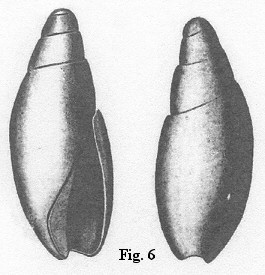
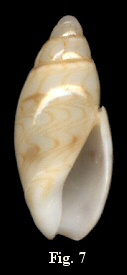
 In the same work Verco also named a somewhat similar
shell Olivella solidula (Ibid. p. 39; figs. 7, 8; our
Fig. 6). It was taken from
Encounter Bay, South Australia, quite near the type locality of O.
adiorygma and about 800 miles east of Hopetoun. He characterized it
as "solid, shining white, smooth, obliquely elongate-oval. Apex blunt,
four whorls, sloping convex, suture well channelled. Aperture oval,
contracting gradually to a linear gutter posteriorly, widely-open in
front, and notched; outer lip simple, smooth; inner lip is a narrow, thick
glaze over the base to the suture, slightly spreading over the columella
.... 6 mm. (by) ... 2.3 mm." As seen in Fig.
6, the shell has relatively narrowly-channeled sutures and
no evident fasciolar or pillar sculpture. The absence of the latter
features contrasts with Olivella [now Belloliva]
exquisita Angas, 1871, which Verco wrote "it closely resembles [but
differs] in being smaller, narrower and pure-white." A solitary specimen
which matched the type illustration of Olivella solidula was found
in my lot of Hopetoun Ramoliva adiorygma. Most regrettably, this
shell was accidentally crushed in preparation for scanning. Our
Fig. 7 is a 8.2 mm B. exquisita in my
collection taken near
shore, Cogee Bay, NSW, Australia. An image of another specimen whitened
with magnesium oxide (Kaicher, 1987; card 4966;
Fig. 8) more clearly demonstrates the pillar and fasciolar
features, which are absent from Olivella solidula.
In the same work Verco also named a somewhat similar
shell Olivella solidula (Ibid. p. 39; figs. 7, 8; our
Fig. 6). It was taken from
Encounter Bay, South Australia, quite near the type locality of O.
adiorygma and about 800 miles east of Hopetoun. He characterized it
as "solid, shining white, smooth, obliquely elongate-oval. Apex blunt,
four whorls, sloping convex, suture well channelled. Aperture oval,
contracting gradually to a linear gutter posteriorly, widely-open in
front, and notched; outer lip simple, smooth; inner lip is a narrow, thick
glaze over the base to the suture, slightly spreading over the columella
.... 6 mm. (by) ... 2.3 mm." As seen in Fig.
6, the shell has relatively narrowly-channeled sutures and
no evident fasciolar or pillar sculpture. The absence of the latter
features contrasts with Olivella [now Belloliva]
exquisita Angas, 1871, which Verco wrote "it closely resembles [but
differs] in being smaller, narrower and pure-white." A solitary specimen
which matched the type illustration of Olivella solidula was found
in my lot of Hopetoun Ramoliva adiorygma. Most regrettably, this
shell was accidentally crushed in preparation for scanning. Our
Fig. 7 is a 8.2 mm B. exquisita in my
collection taken near
shore, Cogee Bay, NSW, Australia. An image of another specimen whitened
with magnesium oxide (Kaicher, 1987; card 4966;
Fig. 8) more clearly demonstrates the pillar and fasciolar
features, which are absent from Olivella solidula.  Olivella solidula was not treated in Wilson
(1994), but he synonymized Olivellopsis Thiele
with Belloliva
Peile, 1922 [type Olivella brazieri Angas, 1877; Cotton, 1955, fig.
9; our Fig. 9], which, like
Belloliva exquisita and B. triticea (Duclos, 1835), has a twisted pillar and
conspicuous fasciolar sculpture. In fact, O. solidula, particularly
a stout form illustrated by Cotton (1955; fig. 11; our
Fig. 10), bears a closer
resemblance to Olivellopsis simplex (Pease, 1868),
Fig. 4, than
either does to Belloliva brazieri. Olivella solidula and
Olivellopsis simplex may well be congeneric. The two smaller shells in
Fig. 1 resemble both these
species. Upon close examination of its dorsal aspect, each of the smaller
Fig. 1 shells has a very faint fasciolar groove/ridge which meets the
outer lip just behind its anterior extremity (as was the case with the
destroyed Hopetoun shell). Although Paul Callomon (personal comm., Sept.
17, 2004) could see no such feature in the Pease lectotype,
in this cosmopolitan and apparently natural group
it is a very
subtle character which may be effaced in older or abraded shells.
If this feature proves consistent from one form to the next, and in
consideration of the channeled sutures of these shells, this group of four
putative taxa are likely very close to or in the Olivella (sensu
lato).
Olivella solidula was not treated in Wilson
(1994), but he synonymized Olivellopsis Thiele
with Belloliva
Peile, 1922 [type Olivella brazieri Angas, 1877; Cotton, 1955, fig.
9; our Fig. 9], which, like
Belloliva exquisita and B. triticea (Duclos, 1835), has a twisted pillar and
conspicuous fasciolar sculpture. In fact, O. solidula, particularly
a stout form illustrated by Cotton (1955; fig. 11; our
Fig. 10), bears a closer
resemblance to Olivellopsis simplex (Pease, 1868),
Fig. 4, than
either does to Belloliva brazieri. Olivella solidula and
Olivellopsis simplex may well be congeneric. The two smaller shells in
Fig. 1 resemble both these
species. Upon close examination of its dorsal aspect, each of the smaller
Fig. 1 shells has a very faint fasciolar groove/ridge which meets the
outer lip just behind its anterior extremity (as was the case with the
destroyed Hopetoun shell). Although Paul Callomon (personal comm., Sept.
17, 2004) could see no such feature in the Pease lectotype,
in this cosmopolitan and apparently natural group
it is a very
subtle character which may be effaced in older or abraded shells.
If this feature proves consistent from one form to the next, and in
consideration of the channeled sutures of these shells, this group of four
putative taxa are likely very close to or in the Olivella (sensu
lato). Based on the findings above, the diagnosis of these
three shells in Fig 1 is (left to right): Olivellopsis species
A [Olivellinae?; first Atlantic and New World record?],
Ramoliva adiorygma (Verco, 1909) [Columbellidae?], Olivellopsis
species B [Olivellinae?; first Indian Ocean
record?]. Needless to say, I appeal to readers to be on the lookout
for other material comparable to these three odd "Rice Olives" so that we
can better appreciate the systematic relationships of each.
Based on the findings above, the diagnosis of these
three shells in Fig 1 is (left to right): Olivellopsis species
A [Olivellinae?; first Atlantic and New World record?],
Ramoliva adiorygma (Verco, 1909) [Columbellidae?], Olivellopsis
species B [Olivellinae?; first Indian Ocean
record?]. Needless to say, I appeal to readers to be on the lookout
for other material comparable to these three odd "Rice Olives" so that we
can better appreciate the systematic relationships of each.